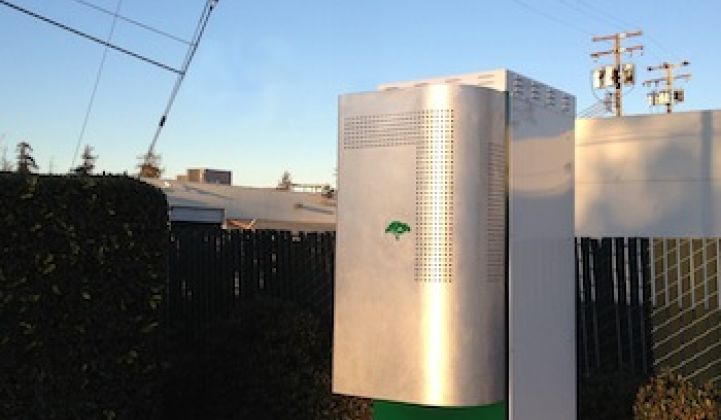Two years ago, Green Charge Networks developed its first set of customer-located storage projects with stimulus money from New York utility Consolidated Edison. Ever since, the company has been relatively quiet, periodically announcing performance data and software upgrades, but no new projects.
Meanwhile, customer-sited storage has seen a little growth spurt -- most notably from competitor Stem, which recently brought in $15 million from GE and Iberdrola, and closed a $5 million fund to finance 15 megawatts of projects.
But after making changes to its hardware and software, Green Charge Networks is now unveiling a new set of project agreements worth 1.1 megawatts of cumulative capacity. The portfolio consists of lithium-ion batteries installed at retail stores, colleges and municipal buildings in California and New York.
"We spent a lot of time over the last couple of years looking at data and refining our product," said Vic Shao, the company's CEO. "We were still in R&D mode at that time, and now we're commercializing."
Like other customer-sited storage firms, Green Charge Networks is primarily focused on using batteries to reduce demand charges. In order to cap demand during peak times, many utilities charge users when they exceed a certain load threshold. According to Shao, many of Green Charge's customers pay demand charges that account for as much as 60 percent to 70 percent of their monthly electricity bills.
"We have a wide swath of customers. But they all have one thing in common: they pay a lot in demand charges," said Shao. He calls his firm's storage service "power efficiency."
After a quiet period, the startup is taking what it learned at its first few installations and attempting to build out a much bigger portfolio of customers. Aggregating projects for demand response and ancillary services to the grid are in the plan, but for now, demand charges are the company's sweet spot.
"If we do nothing else but reduce demand charges, our customers can see a payback of five years," said Shao. He said current customers are on that trajectory.
With help from $12 million in stimulus grants, Green Charge Networks built its platform, installing a few projects at 7-Eleven convenience stores and one Avis rental car location in ConEd's territory in 2012. The 7-Eleven stores turned out to be a success story for the company, said Shao, proving the outdoor systems could provide services through Superstorm Sandy and shed load during ConEd's biggest summer peak ever recorded.
At one 7-Eleven location in Queens, Shao said a system paired with an electric vehicle charger saw a 400 percent spike in usage in the aftermath of Superstorm Sandy. Another store experienced a 56 percent reduction in peak demand during last July's heat wave.
Other smaller -- but equally disastrous -- problems included rodents, sudden spikes in temperature, and excess water vapor from the battery's air conditioning system. Green Charge's battery system has gone through multiple redesigns in order to deal with each challenge.
"Designing a product for the outdoor environment is really hard. You run into all these things that you don't expect. But we now have a product that is solid," said Shao.
The biggest technology change for the company is the hardware package itself. The first set of installations consisted of lithium-ion batteries from Saft and inverters made by Princeton Power. Green Charge now says it is technology-agnostic, and has set up a certification program to find other hardware manufacturers. Saft will still be a provider, but Green Charge is also procuring lithium-ion batteries from Samsung and a few other firms that Shao wouldn't name.
"We are a system integrator and software/services provider," said Shao. "As a small startup trying to enter the space, one of the biggest challenges is bankability. We need to prove our warranty is worth something, so using batteries made by a company like Samsung helps."
And there's another factor that may help the startup: one early customer is lining up for more. Shao said that 7-Eleven has signed contracts for four more stores in California, with the intention of going much bigger if performance targets are hit.
"If we can prove out a summer’s worth of results in California, then we could see a much larger deployment with 7-Eleven," he said.
Green Charge's new portfolio includes ten projects in California and four in New York. The projects, now filed in the Department of Energy's global storage database as "under construction," also include a Walgreens store and a handful of other commercial and municipal customers.
The big question about Green Charge's future is funding. So far, the company has relied on grant programs for installing projects and expanding its small team to fifteen people. However, Shao said the company was "getting pretty close" to closing a fund that will help it expand sales, marketing capabilities and financing. Currently, Green Charge offers operating leases to its customers.
The market is certainly becoming more attractive for customer-sited storage providers. California's new 1.3-gigawatt energy storage target will require half of all new capacity to come from outside providers, much of which will be placed directly at customer locations or on the distribution network. New York is also working on a self-generation incentive program that will benefit storage companies.
At the same time, the regulatory framework is evolving favorably for the market. FERC's Order 784 will allow fast-responding batteries to bid into the frequency regulation market, adding another source of revenue for customers hosting systems.
"This year and next year are going to be transition years in how people think about energy storage," said Shao.
And if Green Charge can prove the performance and economics of its latest round of projects, it could very well be on the front end of that transition.



